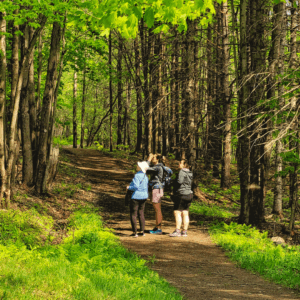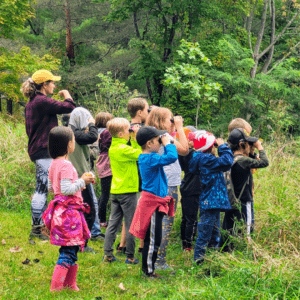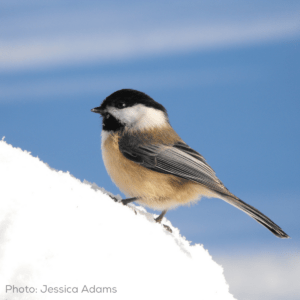Written by Jessica Adams (Nature Nerding)
Reading time: 5-6 minutes
 When you think of birdwatching, you may be inclined to picture a group of people of a certain age walking slowly along a trail, most wearing a bucket hat and a vest of some sort. As they meander slowly along a trail, they periodically stop, look up to the treetops and lift their trusty binoculars to their eyes, excitedly whispering to their fellow birders about what they are seeing.
When you think of birdwatching, you may be inclined to picture a group of people of a certain age walking slowly along a trail, most wearing a bucket hat and a vest of some sort. As they meander slowly along a trail, they periodically stop, look up to the treetops and lift their trusty binoculars to their eyes, excitedly whispering to their fellow birders about what they are seeing.
And you likely are not alone in picturing this! Birdwatching has a bit of a reputation as the hobby of choice for retirees, a passtime reserved for “later in life”, if you will. As a thirty-something who has been fascinated by birds her whole life and who has taken to birdwatching more seriously in the past decade, I am inviting a shift in perspective that just might have you reaching for that dusty pair of binoculars you almost relegated to this year’s yard sale pile…
Birds as a Gateway to Nature

Birds “connect us with here and there, with then and now, as they chatter outside our windows or soar past our lives” (Slow Birding, Joan E. Strassman). In a time where our connection with nature can feel tenuous, birds offer a means of reaffirming the existence of wild animal life amidst our daily human existence.
Whether flitting from bush to feeder in your backyard, singing from the depths of the forest as you walk the trail or paddling leisurely in an urban park pond, birds are very much present in our lives, providing an accessible way of acknowledging, appreciating and connecting with the natural world.
Give Birdwatching or “Birding” a Try this Spring

Birdwatching is sometimes slightly more challenging (possibly downright discouraging) because we tend to hear birds much more often than we actually see them. And while identifying birds based on their song is a rewarding endeavour all its own, it can be frustrating and might not be the best starting point for the “birding curious”.
That being said, there are indeed more opportune times for bird watching.
In April and May, while many eagerly await the arrival of summer, others are completely content with the spring window of opportunity for birding. Not only are various migratory species returning from overwintering grounds making for a rich diversity of species, but the trees and skies are simply buzzing with activity as our feathered friends forage, claim territories, court mates and begin building nests. Spring is primteline and the possibilities for observation are endless!
The added bonus earlier on in spring: the treetops are still relatively bare making it MUCH easier to spot birds as they go about their activities.
Taking the above into consideration – if ever there was a time to try your hand at birdwatching, this is the time of year!
Where and How to Start
If you are even the slightest bit intrigued, here are a few tips for dipping your toe into the wondrous world of birdwatching this spring:
- Location: Choose a place you already frequent. This could be a nearby park, beach or even the birdfeeder in your own backyard. It is fun to visit new places and discover the wildlife that inhabit them, but starting with somewhere close by that you visit often ensures you have regular occasions to engage with the species of that area and practice your skills.
- Approach:
- Brush up on your bird vocabulary. It is much easier to describe something when you are able to use the correct terminology. Start broad with what the Cornell Lab of Ornithology deems the main divisions:
- Beak (or bill)
- Head
- Back
- Throat
- Breast
- Wings
- Tail
- Legs
- Brush up on your bird vocabulary. It is much easier to describe something when you are able to use the correct terminology. Start broad with what the Cornell Lab of Ornithology deems the main divisions:
-
- Start with species you already “know”. Take a step back and imagine you are seeing them for the first time. You may immediately recognize a Blue Jay, for instance… but have you ever stopped to consider what makes a Blue Jay… a Blue Jay?
- Practice careful observation before jumping to identification. As humans, we have the tendency to want to name everything as quickly as possible. Resist the urge to jump to conclusions as you observe the birds that cross your path. Some cues for guiding that careful observation, as outlined by The Cornell Lab:
- Size: What size is the bird relative to species you know? Say you are seeing a Blue Jay for the first time. Size-wise it is larger than a Sparrow, but smaller than a Crow. It is roughly the same size as a Robin.
- Shape: What about its body shape? A Blue Jay may be similar in size to a Robin, but what features of its body shape can help set it apart? One noteworthy feature could be its crest. It also has less of a pronounced belly than the Robin.
- Colour Pattern: What stands out first? The Blue Jay’s vivid blue is certainly not one we come across in all birds. Beyond that, where do we notice contrast? Its face, breast, and belly are white save for one stark marking: a black “chin strap”.
- Behaviour: A few times observing Blue Jays and you may remark that they are quite vocal and far from shy when it comes to taking up space at feeders, for instance.
- Equipment: Start with what you already have. If you have a pair of binoculars or can borrow one, great! If not, practice birdwatching with the naked eye. Especially if you have access to a birdfeeder, this can be much more effective than you might think. I also recommend keeping a journal where you keep track of your observations, whether in writing, sketches or both! One of the best parts of birdwatching is that it requires relatively little investment – mostly just your time and attention. The bucket hat and vest can come later 😉

Above all else, slowing down and refining your birdwatching process ensures that it slowly becomes more intuitive. This makes the experience of encountering new species all the more rewarding and enjoyable as you find yourself increasingly adept at narrowing down the identification possibilities and admiring the wide diversity of species in your very own backyard.
Like with many things in life, the fact birds are so present and available might make us more inclined to disregard them as background features. Life gets busy, time passes quickly and stopping to truly take note of what’s happening around us is a tendency that takes practice. Each opportunity to engage with birds invites one to slow down, engage the senses, get curious and observe carefully.
Consider this as encouragement to all from the birding curious to the seasoned birders to seize these opportunities, even if only from time to time, as they result in boundless peace, wonder, and joy, reminding us of our interconnectedness and shared dependence on this beautiful planet.
Build Your Nature Vocabulary
Use the text and search the web to build your nature vocabulary and try using it the next time you’re out and about in nature, either making observations by yourself or with friends!
- Migratory
- Forage
- Court
- Crest
References
– Building Skills: The 4 Keys to Bird Identification by the Cornell Lab of Ornithology (Cornell University)

